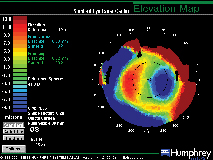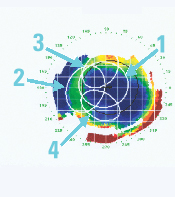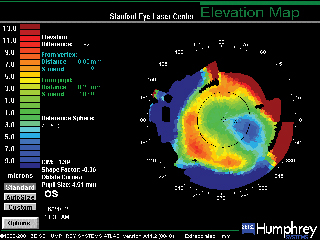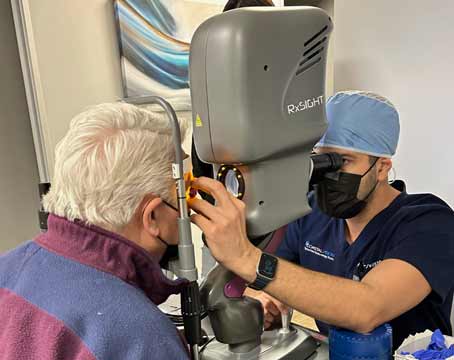Though wavefront-guided ablations may be becoming the king of the hill when it comes to run-of-the-mill spherocylindrical ablations, these high-tech treatments may have to team up with relatively low-tech corneal topography to treat the more complicated corrections involved with highly aberrated corneas. In this, the first in a series that takes a look at what the laser makers are doing to address irregular astigmatism, Review looks at the current progress of Visx and LaserSight.
Visx Custom CAP and CustomVue
Due to the challenges involved with imaging highly aberrated eyes, Visx technology is limited to the off-label use of its CustomVue system for mildly irregular eyes and its Custom Contoured Ablation Profile system to treat eyes that are irregular from decentered ablations. Edward Manche, MD, director of Stanford University's Eye Laser Center, says he's had success with both treatments in the limited number of eyes for which they're indicated.
 |
| Figure 1. This patient's ablation was decentered during his first surgery. |
"CustomVue would be better for someone who had a well-centered primary LASIK treatment but maybe had a non-uniform removal of tissue," says Dr. Manche. "On his topography, there will be areas of over-ablation and some areas of under-ablation, giving the cornea a somewhat bumpy appearance. In such a patient, as long as you can obtain the aberrometry image, you can cut a PreVue lens and show him what the vision could potentially look like by having him look through the lens. Then, if he's satisfied, you can treat him."
One of the main limitations of using CustomVue for these patients is that U.S. surgeons are limited to CustomVue's approved range of correction, which is up to -6 D with up to 3 D of cylinder. Patients can't have mixed astigmatism, hyperopic astigmatism or hyperopia.
To treat decentered ablations, Dr. Manche uses Visx's Custom CAP system. He says that such corneas are pretty much the main indication for C-CAP.
Using C-CAP necessitates having a Zeiss-Humphrey videokeratographer with the special software, called VisionPro, installed. After the surgeon takes topography images of the patient, he pulls up the VisionPro software and views the elevation maps. These images will show the pupil center as well as where the original ablation was centered. At this point, the surgeon has to manually calculate which shapes the laser will need to apply to the cornea in order to recenter the ablation.
"This isn't an automated system like you have with wavefront-guided ablations," says Dr. Manche. "The surgeon needs to design the corrections himself."
The software allows three shapes to be placed on the eye, the myopic ellipse, a spherical correction and a cylindrical correction, though they can be of different sizes and in any number.
As an example of how C-CAP might be used, Dr. Manche refers to a patient with an inferotemporal decentration.
"I'd take a 4-5 mm myopic sphere with about a -2 D correction and place it in the area opposite of the decentration, which, in this case, would be superonasally," he says. "Then, I run a simulation to see what the postop map would look like. I may find it helped a little but that it still needs more. This may mean enlarging the diameter of the sphere and increasing the amount of tissue removed." He says that, once he gets a better-centered treatment, he can then use the myopic ellipses and myopic cylinders to smooth the edges of the treatment and hone the final simulated picture to an appearance he feels comfortable with.
"I usually put about six shapes on the cornea," he says. He says the system usually tends to underestimate how much tissue has to be removed, but that that's better than overestimating and having a divot left over.
 |
| Figure 2. Visx's C-CAP allows the surgeon to plan the steps of an ablation for the patient from Figure 1. |
Of the 10 C-CAP eyes Dr. Manche has treated, he has three-month aberration data on five and acuity data on all of them. At three months, the eyes' higher-order aberrations decreased by an average of 46 percent. Eight of the 10 eyes gained two or more lines of vision, and nine gained one line or remained unchanged. One eye lost a line of uncorrected vision.
Dr. Manche thinks these are just the first steps in treating highly irregular corneas.
"We're going to see aberrometers get better and better," he says. "Eventually, we'll be able to image almost every eye."
The CIPTA Project
An Italian company, Accuus, has developed a topography-based system, called Corneal Interactive Programmed Topographic Ablation, to enable small-spot excimer lasers to smooth out corneal irregularities. Since its inception in 1995, CIPTA has been linked to LaserSight's line of lasers.
Aleksandar Stojanovic, MD, a surgeon at Norway's University of Tromsoe and consultant for Accuus, has used the CIPTA system on irregular corneas using the LaserSight AstraScan laser. He says that one of CIPTA's unique features is that it proceeds from a point of distrusting the aberrated cornea's apparent visual axis, opting instead to create a cleaner one for the patient.
"The philosophy behind the CIPTA system is that it aims for as perfect a cornea as possible," says Dr. Stojanovic. "It takes the patient's spherocylindrical error and visual axis as secondary concerns. Its primary concern is to make the morphology of the cornea as perfect as it can be: meaning smooth, aspheric and prolate. And, the morphologic axis is always through the apex of the cornea. So, if the corneal shape is made regular again at the apex, it's easier for the patient to find a good place to look through, because he will always get good optics as long as the area around the apex is regular."
 |
| Figure 3. After C-CAP, the patient from Figure 1 has a more centered ablation and improved vision. |
Dr. Stojanovic currently has 25 CIPTA patients one year postop. They all had irregularities following previous refractive surgeries. Most of these patients (16) had decentered ablations, but some also had insufficient ablation diameters (5) or irregular surfaces (4). They complained of multiple images, night driving problems and/or decreased best-corrected vision.
In terms of best-corrected vision, twelve of the patients (48 percent) stayed the same, four (16 percent) gained a line and nine (36 percent) gained two or more lines. Subjectively, all of the patients who had multiple images or night driving problems say these difficulties have either improved or are gone.
Though the CIPTA system has been linked to LaserSight's lasers, it's unclear when it will arrive in the United States.
"Accuus has never reached the level of cooperation with LaserSight necessary to release it in the U.S.," says Dr. Stojanovic. He adds that it can be adapted to work with any good flying spot laser system, however, so the option is still there for other scanning spot laser makers.




